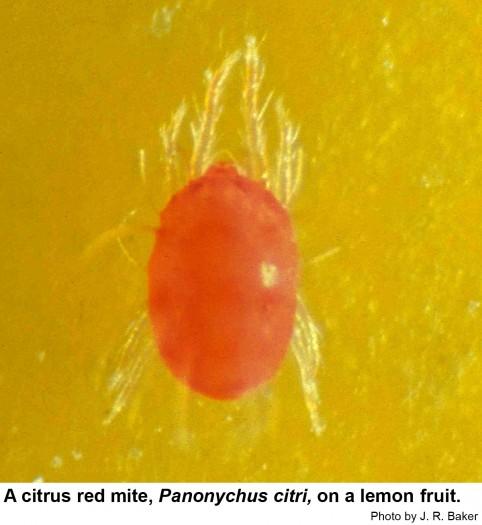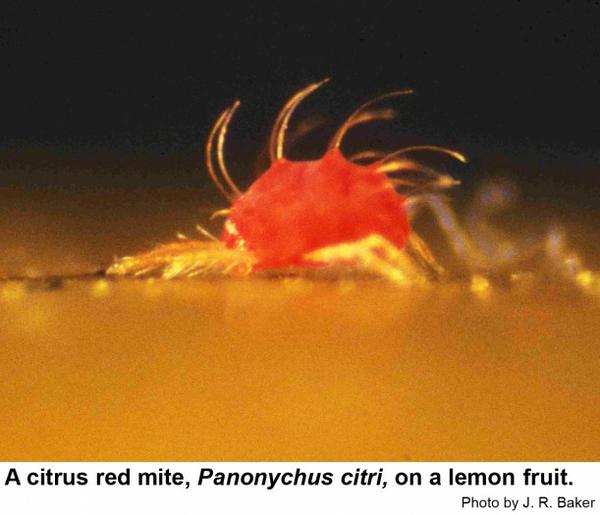Description and Biology
The citrus red mite, Panonychus citri, is a spider mite often associated with citrus, but it also feeds on roses, pears, almond, and some broad-leaved ornamentals. It is a serious pest of citrus in Florida and California. Females are red, plump, and about 0.5 mm long. Males are smaller and taper to the rear. The setae ("hairs") are white with red bases. Females lay 20 to 30 eggs that are are almost spherical. The eggs have a crooked "hair" sticking up from the top called the "stipe." Females lay two or three eggs per day and often spin a thin silk web from the stipe to the substrate surface. Citrus red mite larvae hatch in 8 to 30 days and have three pairs of legs. They then develop through two nymphal stages (with four pairs of legs), each lasting several days, and then molt into adults. In hot weather, development from egg to egg may be as short as 3 weeks, and adults may live 18 days. Development is slower in cool weather. Extremely hot, dry weather or prolonged periods of high humidity are unfavorable for citrus red mite survival.
Host Plants
The citrus red mite feeds on citrus leaves, stems, and fruit as well as Skimmia japonica, rose, and pear. It can invade homes in the fall and spring to infest citrus plants on porches and sunrooms. At first the mites cause a silvery stippling of the leaves as they suck out the contents of the plant cells in the epidermis and mesophyll. Scratch-like feeding marks turn leaves and green immature fruit noticeably pale. Injured mature oranges and lemons turn a pale straw yellow. If uncontrolled, citrus red mites may cause complete leaf drop.
Residential Recommendation
One of the plant-shine oils, horticultural oils, or insecticidal soaps should give adequate control of citrus red mites. These are both effective and safe for humans when used according to the directions on the label. Several house plant spray mixtures are also on the market. These should control citrus red mites as well.
References
- A Guide to Citrus Mite Identification. Futch, S. H. et al. 2013. University of Florida Solutions for Your Life, Pub. #HS-806.
- Field Evaluation of Predacious Mites (Acari: Phytoseiidae) for Biological Control of Citrus Red Mite, Panonychus citri (Trombidiformes: Tetranychidae). Fadamiro, H. Y. et al. 2013. Florida Entomol. 91 (1): 80 - 91.
- The Biology and Fecundity of the Citrus Red Mite Panonychus citri (McGregor) (Acari: Tetranychidae) at Different Temperatures under Laboratory Conditions. Kasap, I. 2009. Turkish Journal of Agr. and Forestry 33(6): 593-600.
- Extension Plant Pathology Publications and Factsheets
- Horticultural Science Publications
- North Carolina Agricultural Chemicals Manual
For assistance with a specific problem, contact your local N.C. Cooperative Extension Center.
This Factsheet has not been peer reviewed.
Publication date: Nov. 9, 2013
Revised: Sept. 12, 2019
Recommendations for the use of agricultural chemicals are included in this publication as a convenience to the reader. The use of brand names and any mention or listing of commercial products or services in this publication does not imply endorsement by NC State University or N.C. A&T State University nor discrimination against similar products or services not mentioned. Individuals who use agricultural chemicals are responsible for ensuring that the intended use complies with current regulations and conforms to the product label. Be sure to obtain current information about usage regulations and examine a current product label before applying any chemical. For assistance, contact your local N.C. Cooperative Extension county center.
N.C. Cooperative Extension prohibits discrimination and harassment regardless of age, color, disability, family and marital status, gender identity, national origin, political beliefs, race, religion, sex (including pregnancy), sexual orientation and veteran status.



